George
Washington Laying the Cornerstone of the United States Capital
Mural and
Commemorative Medallion
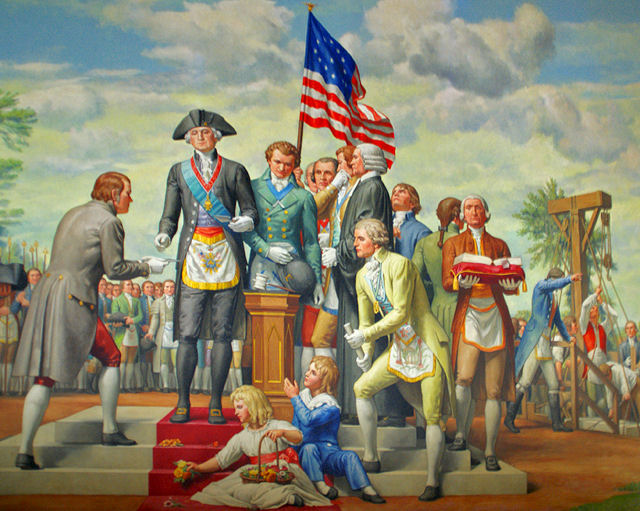
This majestic mural was the work
of Allyn Cox, one of the most talented muralists in America. Cox worked for
approximately 30 years at the Capitol building; he painted 26 murals in the
House side, one in the Senate side and the frieze on the Capitol dome.
The mural shows President Washington receiving a silver plate which was
deposited underneath the Cornerstone of the United States Capitol at the Masonic
Ceremony he conducted under the auspices of the Grand Lodge of Maryland.
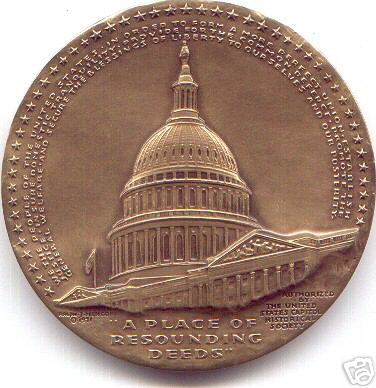
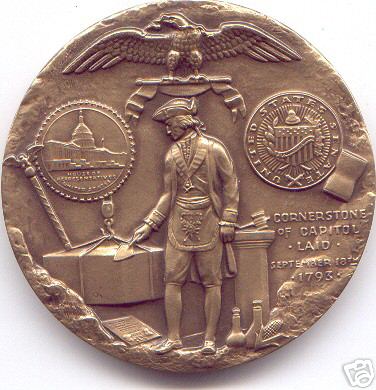
This beautiful medallion depicts and
commemorates the 180th Anniversary of the laying of the Cornerstone of the U.S. Capital by Brother
George Washington on September 18, 1793. He is shown wearing his Masonic Jewel
and Apron and spreading the the cement of Brotherly Love and Affection with
his Masonic Trowel. This medal was made in 1971 and released in
1973. The medal is bronze, it is 2 1/2 inches in diameter & in uncirculated
condition. The medallist was Ralph J. Menconi and it was authorized by the
United States Capitol Historical Society. The obverse shows George Washington
in full Masonic regalia, applying the cement of Brotherly Love to a suspended
cornerstone. There is an Eagle at the top and medallions of the U.S. Capitol
on the left and U.S. Senate shield on the right. To the bottom right it reads
"CORNERSTONE - OF CAPITOL - LAID - SEPTEMBER 18TH - 1793". The reverse shows
the Capitol rotunda's exterior and below the building it reads "A PLACE OF -
RESOUNDING - DEEDS". To the bottom right it reads "AUTHORIZED - BY - THE
UNITED - STATES CAPITOL - HISTORICAL - SOCIETY". Around the top portion there
is a rim of stars and a three line inscription beginning with "WE THE PEOPLE
OF THE UNITED STATES".

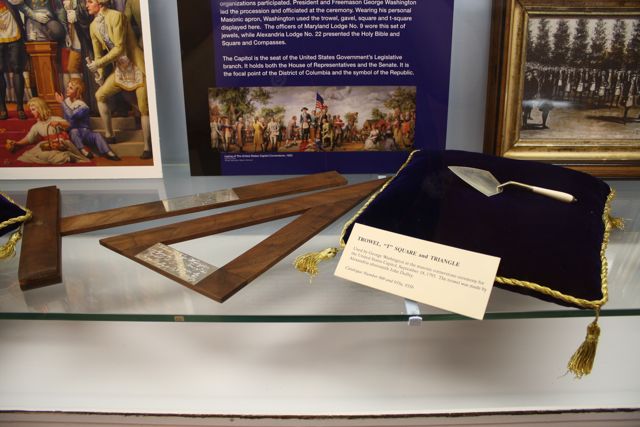
The tools used at the cornerstone ceremony,
on display at the George Washington Masonic Memorial in Alexandria, VA
After the reading of the
inscription, the cornerstone was made ready. President Washington, the Grand
Master pro tempore Joseph Clark of Maryland, and the three attending Masters of
the lodges present—Elisha Cullen Dick of Alexandria No. 22, Valentine Reintzel
of Maryland Lodge No. 9, and James Hoban of Federal Lodge No. 15—took the plate
and stepped down into the trench. A beautiful silver trowel and marble gavel had
been crafted especially for the occasion by Brother John Duffey, a silversmith
in Alexandria who was a member of the president’s home lodge, Fredericksburg
Lodge No. 4. The trowel had a silver blade, a silver shank and an ivory handle
with a silver cap. Brother Duffey had also crafted Masonic working tools of
walnut for use in the ceremony.
The square was applied, a symbol
of virtue, to make certain that each angle of the stone was perfectly cut. Next,
the level, a symbol of equality, was used it to ascertain that the stone was
horizontally correct. And last, the plumb, an emblem of morality and rectitude,
showed that the stone was perfectly upright. The stone was declared square,
level and plumb and therefore suitable as the foundation for the new building.
Kernels of wheat were sprinkled over the stone from a golden cup as a symbol of
goodness, plenty and nourishment. Wine was poured over it from a silver cup, a
symbol of friendship, health and refreshment. Finally, drops of oil glistened
down its sides like the sacred oil that ran down upon Aaron’s beard in the Old
Testament, “to the skirts of his garments; as the dew of Hermon, and as the dew
that descended upon the mountains of Zion.” The oil symbolized joy, peace and
tranquility.
President Washington placed the silver plate on the cornerstone, and it was
consecrated in the Masonic tradition with corn, wine and oil. The silver trowel
was used to spread a small amount of cement, and the marble gavel to
symbolically tap the stone into place.
Today, the left “valve” doors of the Senate depict a scene from the laying of
the Capitol cornerstone, clearly showing Washington in his Masonic apron, and
there is a fresco painted in the Capitol depicting the scene, as well.
Non-Masons may be especially curious about the “year of Masonry” on the
cornerstone’s plate—5793. One of the more confounding customs has to do with the
way Freemasons date documents. The Gregorian calendar was standardized by Pope
Gregory XIII in 1582, though the non-Catholic Western world took another 200
years before they went along with the pope’s idea. Since 1776, most of the world
has been on the same calendar page, though Greece and Russia didn’t adopt it
until after World War I. Because Western Europe and America switched to the
Gregorian calendar in the mid-1700s, conflicting ages are attributed to some of
the notable figures of the period. Because of the confusion during the
changeover, they themselves weren’t always sure of their real age.
In 1658, Bishop James Ussher in Ireland believed he had determined the exact
date of the creation of the world. Using the biblical account along with a
comparison of Middle Eastern histories, Hebrew genealogy and other known events,
he determined that the Earth was created on Sunday, October 23, 4004 B.C. At
about the same time, John Lightfoot, vice chancellor of Cambridge University,
went on to clarify that the Creation actually happened at about 9 a.m.
Ussher called his calendar Anno
Mundi, the Year of the World. By 1700, Ussher and Lightfoot’s calculations of
the date and time of the Creation were accepted as fact by most Christian
denominations. Beginning in 1701, new editions of the King James Bible clearly
stated it right up front. Because Ussher’s Creation date was so strongly
believed at the time of modern Freemasonry’s origin, the Masons began dating
their documents using 4004 B.C. as their beginning year . . . sort of. 4004 was
an inconvenient number to remember, so Masons simply took the current year and
added 4,000 to it. So, A.D. 1793 became 5793 Anno Lucis, or A.L., and A.D. 2007
would be 6007 A.L. Anno Lucis means “year of light” in Latin. Masons called it
that to coincide with the Genesis passage, “And God said, ‘Let there be light’;
and there was light.” They did this early on to lend their fraternity an air of
great and solemn antiquity. If they dated their documents as being 5717 years
old, they’d certainly sound more respectable and impressive than some newly
formed London drinking club. Today, you will often see two dates on Masonic
cornerstones—both A.D. and A.L.
After seven years, the U.S.
Congress met in the first completed portion of the Capitol, the North Wing, in
November 1800. In the 1850s, major extensions to the North and South ends of the
Capitol were required because of rapid westward expansion of the country and the
subsequent growth of Congress. During this expansion, the distinctive dome that
makes the building so readily identifiable replaced a less grandiose, much
shorter, squatter (and leaky) one that made up Dr. Thornton’s original design.
Since that time, additional office buildings have been built up on streets
adjacent to the Capitol to handle the needs of an ever-increasing, swollen
bureaucracy.
Because of modifications to the
building following its burning in 1814 at the hands of the British, along with
expansions in the 1850s, the original cornerstone laid by George Washington and
the Freemasons has been lost. In 1893, on the one hundredth anniversary of the
laying of the Capitol’s cornerstone, a plaque was placed near the spot where it
was believed to have originally been installed.
Beneath this tablet
the corner stone of the Capitol of the
United States of America
was laid by
George Washington
First President September 18, 1793
On the Hundredth Anniversary
in the year 1893
In presence of the Congress the Executive and the
Judiciary
a vast concourse of the grateful people
of the District of Columbia commemorated the
event.
Grover Cleveland President of the United States
Adlai Ewing Stevenson Vice President
Charles Frederick Crisp Speaker, House of
Representatives
Daniel Wolsey Hoorhees Chairman Joint Committee of
Congress,
Lawrence Gardner Chairman Citizens Committee

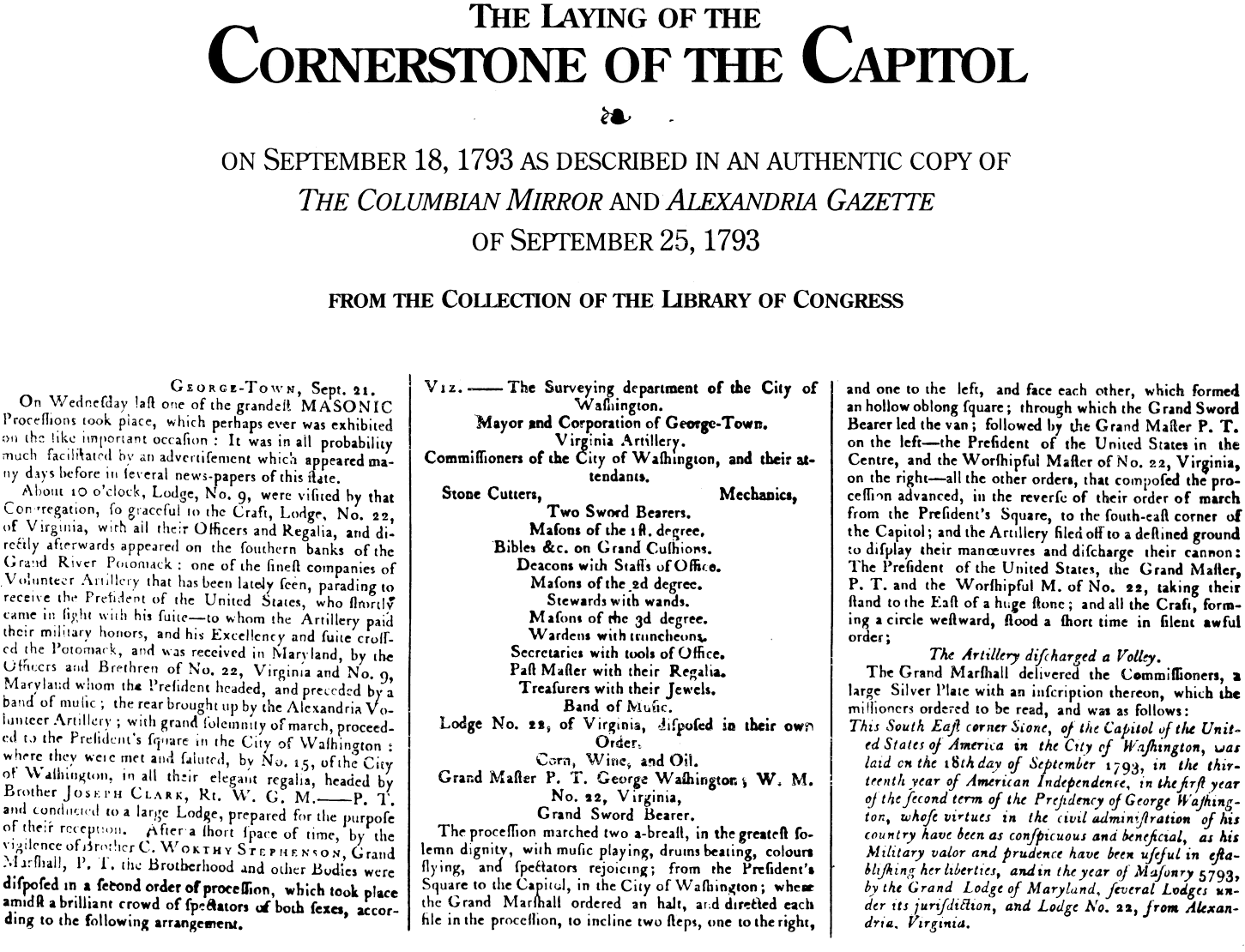

The United
States Senate Gavel
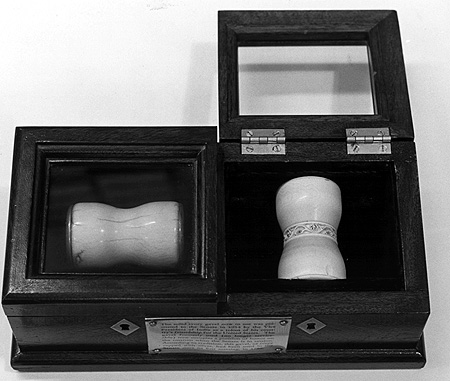
The
unique gavel of the
United States Senate has an
hourglass
shape and no handle. The gavel in current use was presented to the Senate by
the Republic of
India and first used on November 17, 1954. This gavel replaced an
ivory gavel
which had been in use since at least 1789 and had deteriorated over the years.
In 1952, silver plates were added to both ends of the old gavel in an attempt
to prevent further damage to it. In 1954, it broke when
Vice President
Richard Nixon used it during a heated debate on
nuclear energy. Unable to obtain a piece of ivory large enough to replace
the gavel, the Senate appealed to the
Indian embassy. India presented to the United States the solid ivory
replica
still in use.[4]

The Unites
States House of Representatives Mace
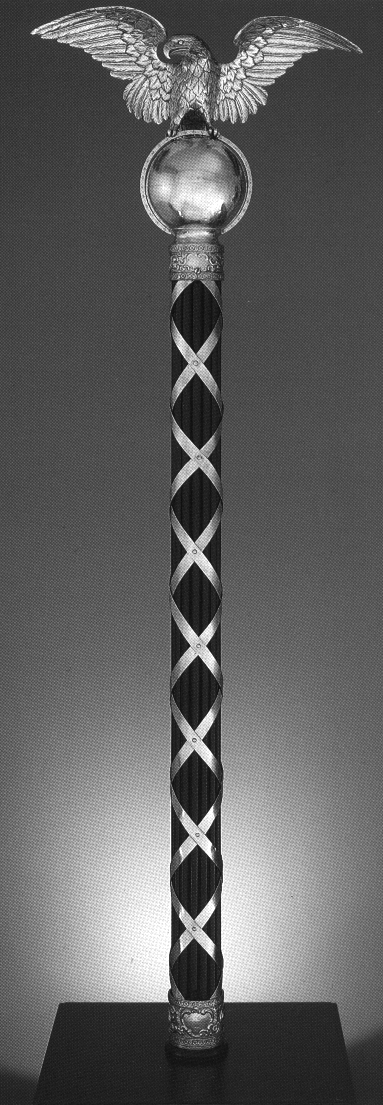
History
In one of its first resolutions,
the
U.S. House of Representatives of the
1st Federal Congress (April 14, 1789) established the
Office of the Sergeant at Arms. The first
Speaker of the House,
Frederick Muhlenberg of
Pennsylvania, approved the
ceremonial mace as the proper symbol of the Sergeant at Arms in carrying out
the duties of this office.
The current mace has been in use
since December 1, 1842. It was created by New York
silversmith William Adams, at a cost of $400, to replace the first one that
was destroyed when the
Capitol Building was burned on August 24, 1814 during the
War of
1812. A simple wooden mace was used in the interim.
Description
The design of the mace is derived
from an
ancient battle weapon and the
Roman fasces.
The ceremonial mace is 46 inches high and consists of 13
ebony rods –
representing the
original 13 states of the
Union
– bound together by silver strands criss-crossed over the length of the pole.
Atop this shaft is a silver globe on which sits an intricately cast solid silver
eagle.
Sitting above the ebony rods of
the mace is a cast-silver globe, which holds an eagle with spread wings. The
continents are etched into the globe, with North America facing front. The
eagle, the national bird, is cast in solid silver.
Procedure
For daily sessions of the House,
the Sergeant carries the silver and ebony mace of the House in front of the
speaker, in procession to the
rostrum. When
the House is in
session, the mace stands on a cylindrical pedestal of green
marble to the
Speaker's right. When the House is in
committee, it is moved to a pedestal next to the Sergeant at Arms' desk.[1]
Thus, members entering the chamber know immediately whether the House is in
session or in committee. When the body resolves itself into
Committee of the whole House on the State of the Union, the Sergeant moves
the mace to a lowered position, more or less out of sight.
Disciplinary usage
In accordance with the
House Rules, on the rare occasion that a
member becomes unruly, the Sergeant at Arms, upon order of the Speaker,
lifts the mace from its pedestal and presents it before the offenders, thereby
restoring order.
When a confrontation on the House
floor becomes unruly, the tradition is that, upon direction of the Speaker, the
Sergeant at Arms will step between the combatants with the mace. Usually,
because the members are able to edit the
Congressional Record before it goes to print, there is no mention of the
actual use of the mace in this capacity. The most recent recorded use of the
mace was on July 29, 1994, when Democratic Rep.
Maxine Waters failed to stop speaking after she was accused of insulting
Rep.
Peter T. King.
From
Wikipedia
